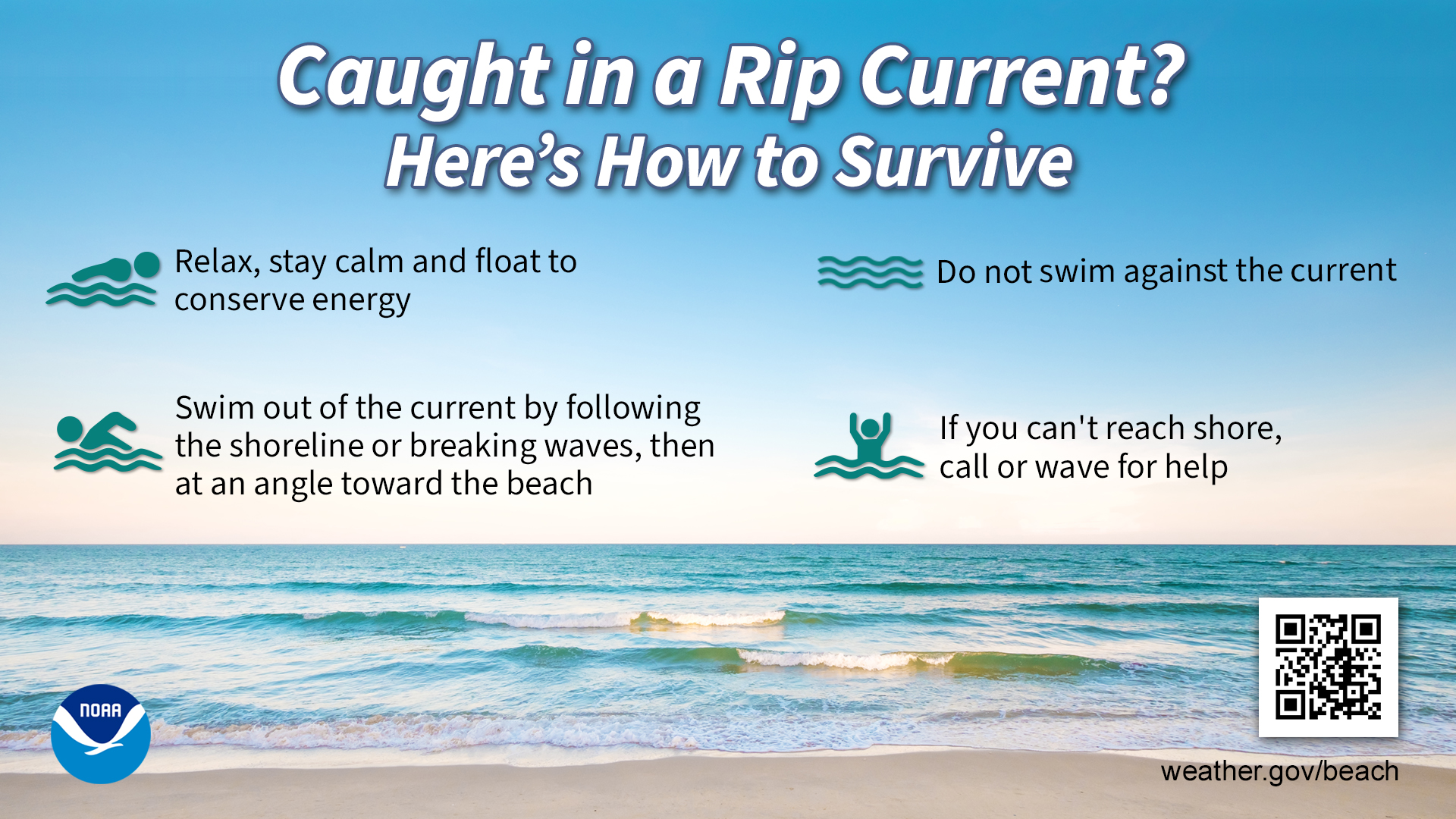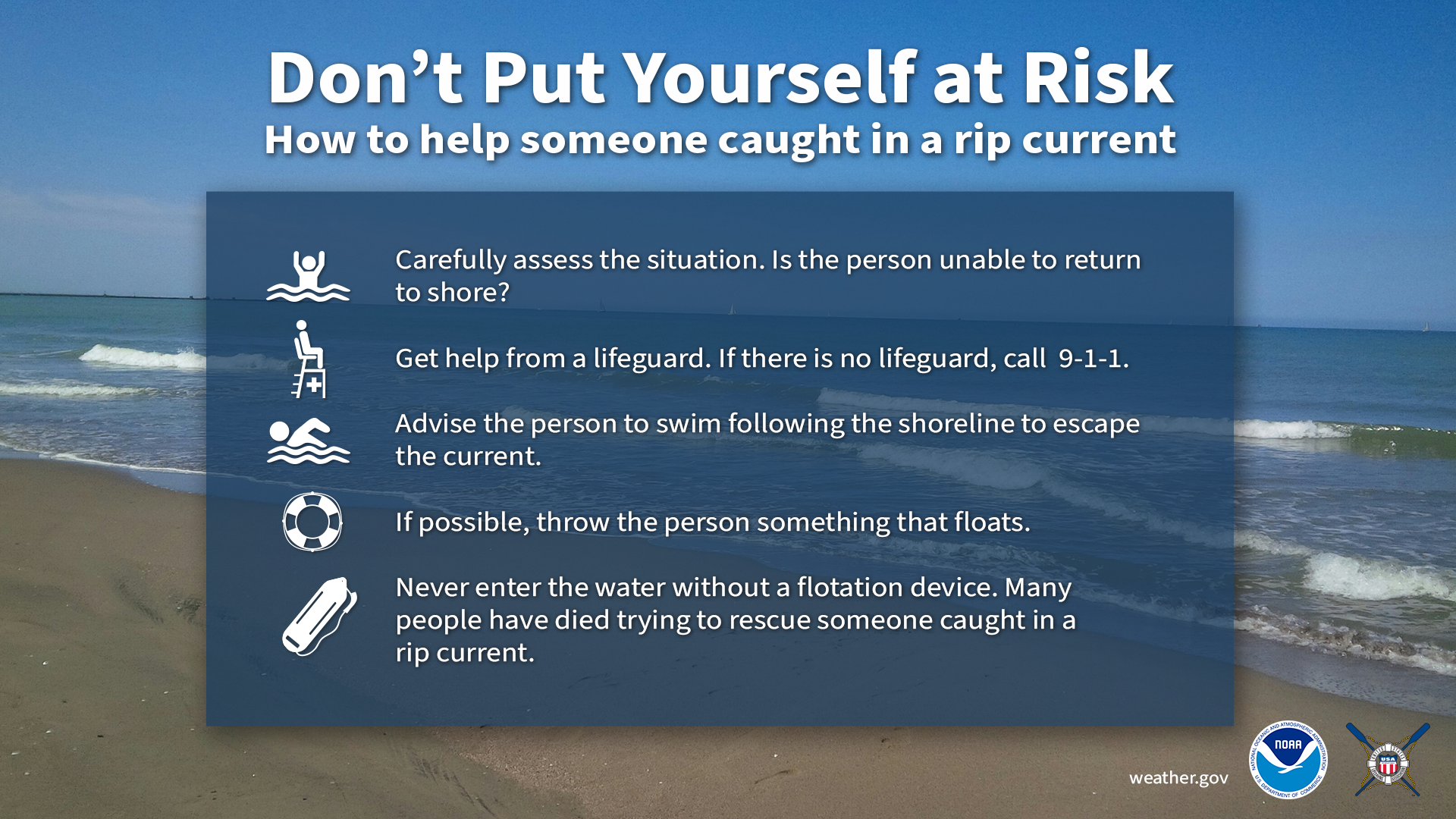Rip current safety ahead of the Memorial Day weekend (Spanish version)
8 things you should know BEFORE you go in the water!
May 22, 2024 - NOAA’s National Weather Service (NWS) is reminding beach goers ahead of the Memorial Day weekend to be aware of the dangers of rip currents and other beach hazards -- and to only swim on beaches that have a lifeguard, if at all possible. There have already been seven drownings from rip currents this year. Knowing about the dangers of rip currents could save your life.
Eight things you should Know BEFORE you go in the water!
- Check the National Weather Service forecast: Before you leave for the beach, check your local surf zone and beach hazards forecasts by clicking on the map to get the forecast for your area. Remember that water conditions can change quickly during the day, so be sure to check for updates and be aware of what’s going on around you!

- What are rip currents and how to escape them? Being aware of what rip currents are and how they can impact you, including what to do if you are caught in one, will put you in a much better position to safely enjoy your time at the beach. Make sure your friends and family members also know what to do, and that children are kept within arm’s reach at all times!
Rip currents are channelized currents of water flowing away from the shore at beaches. A rip current can reach speeds that are faster than the best Olympic swimmers. Typically, they form at breaks in sandbars, and near man-made structures, such as jetties and piers, and natural structures like caves/cliffs. Rip currents are common and can be found on any beach where there are breaking waves, including the Great Lakes and Gulf of America. Take a few minutes to learn more on the NOAA Rip Current Science site.
- How to survive a rip current:
- Most importantly, stay calm and do not panic. Rip currents pull you away from the shore, they don’t pull you under the water.
- Your natural instinct may be to try to swim back to shore…but DO NOT swim against the current. Trying to swim against a rip current will only exhaust your energy; energy you need to survive and escape.
- If you feel you can safely swim, you may be able to escape the current by swimming in the direction along (parallel to) the shoreline until you feel the current becoming weaker. Then, you can swim at an angle towards the beach.
- ​If at any time you feel you will be unable to reach shore, do whatever you can to draw attention to yourself. Face the shore, wave your arms, and yell for help.
- How do you help someone else? Don’t become a victim while trying to help someone else! Many people have died trying to rescue rip current victims.
- Get help from a lifeguard.
- If a lifeguard is not present, call 9-1-1, then try to direct the victim to swim following the shoreline to escape.
- If possible, throw the rip current victim something that floats.
- If you must attempt to rescue someone, never enter the water without a flotation device.​​

- Swim near lifeguards: If possible, only swim at beaches with lifeguards. The chances of drowning at a beach with lifeguards are 1 in 18 million (U.S. Lifesaving Association). When you arrive at the beach, ask the lifeguards about rip currents and other hazards, and look for designated swimming areas. If you choose to swim at beaches without a lifeguard, never swim alone. Make sure at least someone in your group has a cell phone so you or another person can call 911 for help.
- Never take your eyes off of small children: It only takes a moment for tragedy to strike and there are many distractions at the beach. Watch your children at all times, and always keep them within arm’s reach when in the water.
- Know what the warning flags mean and check signs: Read the beach safety signs at the entrance to the beach. Look for beach warning flags, often posted on or near a lifeguard's stand. Know what the warning flags mean. These flags are there to protect you. Warning flags aren't used in all areas and their meaning can vary from area to area. Check this link from the U.S. Lifesaving Association for info on the beach you are visiting.
- Be aware that swimming in an ocean is different from swimming in a pool: Crashing waves, gusty winds, and dangerous currents are just a few ways in which swimming in the ocean is much different than a swimming pool. Changing ocean currents and winds can quickly exhaust your energy and strength. Many swimming programs now offer lessons in how to escape a rip current. According to the United State Lifeguard Association (USLA), learning how to swim is one of the best defenses against drowning.
Resources:
Media Contact: Michael Musher, NOAA Communications, michael.musher@noaa.gov

